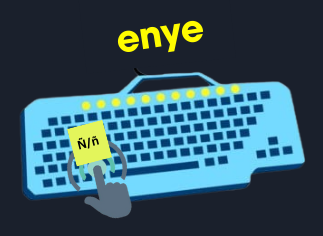Enye or Small Enye? The Common Mistakes People Make in Writing Filipino & Spanish Words
If you’ve ever typed “senor” instead of “señor,” you’re not alone. Especially those who use English-based keyboards struggle to include Enye or small enye (ñ) in their digital writing. It may seem like a tiny squiggle on top of letter “n,” but the letter Ñ is far more important than most people realize. In Filipino, a Filipino name is “Peafrancia,” and in Spanish, a word is “ao,” any misplaced letter completely alters its meaning.

Enye and small enye mistakes made in Filipino and Spanish are discussed in this guide. Here is some advice if you have ever skipped the letter, or copied it from someone else.
Mistake #1: Using “N” Instead of “Ñ”
Most commonly, people type a plain “n” instead of Enye or small Enye (ñ). It may seem insignificant, but in many cases, it completely changes the meaning of the word. Here are some examples:
| Incorrect | Correct | Meaning |
|---|---|---|
| ano | año | “what” vs. “year” |
| senor | señor | meaningless vs. “sir” |
| canon | cañon | church rule vs. “canyon” |
The same is true for surnames and place names in Filipino:
- “Pinon” vs. “Piñon”
- “Pena” vs. “Peña”
Using the wrong letter in formal settings can cause confusion, miscommunication, and embarrassment.
Mistake #2: Using All Caps and Ignoring Ñ
In some cases, typing in all capitals will remove the uppercase Enye symbol altogether. Many people just write “NINOY” instead of “NIÑOY,” thinking it doesn’t matter. A missing Enye or small Enye in names, especially on legal documents or IDs, can lead to official mistakes.
You should use the uppercase “Ñ” while the lowercase is “ñ”. When writing proper names and titles, be sure to use the correct casing and accents.
Mistake #3: Copy-Pasting Ñ from Google or Elsewhere
Some people copy letters from websites or Google searches because they don’t know how to type them. It works temporarily, but it breaks formatting, especially on forms and emails.
When writing resumes, academic papers, or using third-party apps that don’t render pasted special characters correctly, this quick fix becomes a headache in the long run.
For best results, learn how to type Enye or small Enye natively on your keyboard (Alt+164 on Windows, Alt+165 on Mac).
Mistake #4: Thinking “Enye” is Optional
Some people think Enye or small enye is “just decoration.” That’s not true. Ñ is a separate letter in the Spanish and Filipino alphabets. The word has its own pronunciation and place in dictionaries.
Using N instead of Ñ isn’t just a spelling error—it’s a linguistic mistake that changes how a word sounds and what it means.
Mistake #5: Not Adding Ñ Support in Websites and Forms
Whether you are a developer or a blogger, if your website form is not fully language-compatible, it isn’t fully compatible. Names like “Muñoz” or “Peña” must be typed correctly in form fields, or you risk user frustration and data issues.
Your input forms should support Enye or small Enye characters, especially in login names, emails, and address fields, if you’re designing for a global or Filipino/Spanish audience.
Final Tips: How to Master Enye or Small Enye in Daily Typing
Here are some tips for writing clean, culturally appropriate, and correct Filipino or Spanish text:
Keyboard shortcuts:
- In Windows, press Alt+164 (ñ), Alt+165 (Ñ)
- On a Mac, press Option+N, then N
- Make sure your mobile keyboard supports Spanish or Filipino
- For language-specific autocorrect, use browser extensions
- You can practice regularly by typing your name or common phrases with Ñ.
FAQs – Enye or Small Enye
Conclusion
Enye or small enye deserve proper attention, regardless of whether they are text messages, school papers, or legal forms. Millions of names and words contain this letter as a core part of their identity and meaning. You not only improve your writing by avoiding common mistakes, but you also demonstrate respect for language, culture, and people by learning how to type correctly.


